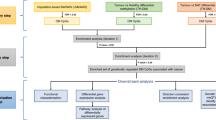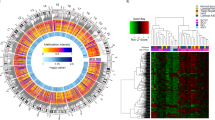Abstract
DNA methylation in peripheral blood is associated with breast cancer (BC) but has mainly been studied in Caucasian populations. We investigated the association between blood-based methylation of receptor-associated protein of the synapse (RAPSN) and BC in Chinese population. The methylation levels of 12 RAPSN CpG sites were quantitatively evaluated by mass spectrometry in two case–control studies with 283 sporadic BC cases and 331 controls totally. The association was analyzed by logistic regression adjusted for covariants. The RAPSN methylation levels in patients with variant clinical characteristics were investigated by non-parametric tests. We found a significant association between BC and altered RAPSN methylation in blood in women at premenopausal and perimenopausal (age < 50 years old), but not in the elder women. This was approved by two independent case–control studies as well as by combining the subjects of the two studies (taken all subjects together, age < 50 years old, per 5% of methylation, odds ratio (OR) range from 1.17 to 1.30 for two CpG sites; OR = 0.75 for one CpG site; all p values < 0.02). This age-related RAPSN methylation was further modified by human epidermal growth factor receptor 2 (HER2) status (age < 50 years old, HER2 negative, per 5% of methylation, OR range from 1.27 to 1.48 for two CpG sites; OR = 0.76 for one CpG site; all p values < 0.02). We elucidated an association between BC and blood-based RAPSN methylation influenced by age and the status of HER2 in Chinese population.
This is a preview of subscription content, access via your institution
Access options
Subscribe to this journal
Receive 12 print issues and online access
$259.00 per year
only $21.58 per issue
Buy this article
- Purchase on Springer Link
- Instant access to full article PDF
Prices may be subject to local taxes which are calculated during checkout
Similar content being viewed by others
References
Bray F, Ferlay J, Soerjomataram I, Siegel RL, Torre LA, Jemal A. Global cancer statistics 2018: GLOBOCAN estimates of incidence and mortality worldwide for 36 cancers in 185 countries. CA Cancer J Clin. 2018;68:394–24.
Momenimovahed Z, Salehiniya H. Epidemiological characteristics of 577and risk factors for breast cancer in the world. Breast Cancer. 2019;11:151–64.
Rivera-Franco MM, Leon-Rodriguez E. Delays in breast cancer detection and treatment in developing countries. Breast Cancer. 2018;12:1178223417752677.
Jafari SH, Saadatpour Z, Salmaninejad A, Momeni F, Mokhtari M, Nahand JS, et al. Breast cancer diagnosis: imaging techniques and biochemical markers. J Cell Physiol. 2018;233:5200–13.
Baylin SB, Jones PA. Epigenetic Determinants of Cancer. Cold Spring Harb Perspect Biol. 2016;8. https://doi.org/10.1101/cshperspect.a019505.
Jankowska AM, Millward CL, Caldwell CW. The potential of DNA modifications as biomarkers and therapeutic targets in oncology. Expert Rev Mol Diagn. 2015;15:1325–37.
Craig JM, Bickmore WA. The distribution of CpG islands in mammalian chromosomes. Nat Genet. 1994;7:376–82.
Watanabe Y, Maekawa M. Methylation of DNA in cancer. Adv Clin Chem. 2010;52:145–67.
Ehrlich M. Cancer-linked DNA hypomethylation and its relationship to hypermethylation. Curr Top Microbiol Immunol. 2006;310:251–74.
Subramaniam D, Thombre R, Dhar A, Anant S. DNA methyltransferases: a novel target for prevention and therapy. Front Oncol. 2014;4:80.
Gyorffy B, Bottai G, Fleischer T, Munkacsy G, Budczies J, Paladini L, et al. Aberrant DNA methylation impacts gene expression and prognosis in breast cancer subtypes. Int J Cancer. 2016;138:87–97.
Crowley E, Di Nicolantonio F, Loupakis F, Bardelli A. Liquid biopsy: monitoring cancer-genetics in the blood. Nat Rev Clin Oncol. 2013;10:472–84.
Tang Q, Cheng J, Cao X, Surowy H, Burwinkel B. Blood-based DNA methylation as biomarker for breast cancer: a systematic review. Clin Epigenetics. 2016;8:115.
Brennan K, Garcia-Closas M, Orr N, Fletcher O, Jones M, Ashworth A, et al. Intragenic ATM methylation in peripheral blood DNA as a biomarker of breast cancer risk. Cancer Res. 2012;72:2304–13.
Hoffman AE, Yi CH, Zheng T, Stevens RG, Leaderer D, Zhang Y, et al. CLOCK in breast tumorigenesis: genetic, epigenetic, and transcriptional profiling analyses. Cancer Res. 2010;70:1459–68.
Tang Q, Holland-Letz T, Slynko A, Cuk K, Marme F, Schott S, et al. DNA methylation array analysis identifies breast cancer associated RPTOR, MGRN1 and RAPSN hypomethylation in peripheral blood DNA. Oncotarget. 2016;7:64191–202.
Yang R, Stocker S, Schott S, Heil J, Marme F, Cuk K, et al. The association between breast cancer and S100P methylation in peripheral blood by multicenter case-control studies. Carcinogenesis. 2017;38:312–20.
Yin Q, Yang X, Li L, Xu T, Zhou W, Gu W, et al. The association between breast cancer and blood-based methylation of S100P and HYAL2 in the Chinese population. Front Genet. 2020;11:977.
Hachiya T, Furukawa R, Shiwa Y, Ohmomo H, Ono K, Katsuoka F, et al. Genome-wide identification of inter-individually variable DNA methylation sites improves the efficacy of epigenetic association studies. NPJ Genom Med. 2017;2:11.
Komaki S, Shiwa Y, Furukawa R, Hachiya T, Ohmomo H, Otomo R, et al. iMETHYL: an integrative database of human DNA methylation, gene expression, and genomic variation. Hum Genome Var. 2018;5:18008.
Richardson B. Impact of aging on DNA methylation. Ageing Res. Rev. 2003;2:245–61.
Zhang X, Ho SM. Epigenetics meets endocrinology. J Mol Endocrinol. 2011;46:R11–32.
Dunneram Y, Greenwood DC, Cade JE. Diet, menopause and the risk of ovarian, endometrial and breast cancer. Proc Nutr Soc. 2019;78:438–48.
Houseman EA, Accomando WP, Koestler DC, Christensen BC, Marsit CJ, Nelson HH, et al. DNA methylation arrays as surrogate measures of cell mixture distribution. BMC Bioinforma. 2012;13:86.
Talens RP, Boomsma DI, Tobi EW, Kremer D, Jukema JW, Willemsen G, et al. Variation, patterns, and temporal stability of DNA methylation: considerations for epigenetic epidemiology. FASEB J. 2010;24:3135–44.
Engel AG. Genetic basis and phenotypic features of congenital myasthenic syndromes. Handb Clin Neurol. 2018;148:565–89.
Ravenscroft G, Sollis E, Charles AK, North KN, Baynam G, Laing NG. Fetal akinesia: review of the genetics of the neuromuscular causes. J Med Genet. 2011;48:793–1.
Zhuang QS, Zheng H, Gu XD, Shen L, Ji HF. Detecting the genetic link between Alzheimer’s disease and obesity using bioinformatics analysis of GWAS data. Oncotarget. 2017;8:55915–9.
Aittaleb M, Chen PJ, Akaaboune M. Failure of lysosome clustering and positioning in the juxtanuclear region in cells deficient in rapsyn. J Cell Sci. 2015;128:3744–56.
Gautam M, Noakes PG, Mudd J, Nichol M, Chu GC, Sanes JR, et al. Failure of postsynaptic specialization to develop at neuromuscular junctions of rapsyn-deficient mice. Nature. 1995;377:232–6.
Lee CH, Huang CS, Chen CS, Tu SH, Wang YJ, Chang YJ, et al. Overexpression and activation of the alpha9-nicotinic receptor during tumorigenesis in human breast epithelial cells. J Natl Cancer Inst. 2010;102:1322–35.
Key TJ, Chen J, Wang DY, Pike MC, Boreham J. Sex hormones in women in rural China and in Britain. Br J Cancer. 1990;62:631–6.
Parida S, Sharma D. The Microbiome-Estrogen Connection and Breast Cancer Risk. Cells. 2019;8. https://doi.org/10.3390/cells8121642.
Prall OW, Rogan EM, Sutherland RL. Estrogen regulation of cell cycle progression in breast cancer cells. J Steroid Biochem Mol Biol. 1998;65:169–74.
Thomas T, Thomas TJ. Regulation of cyclin B1 by estradiol and polyamines in MCF-7 breast cancer cells. Cancer Res. 1994;54:1077–84.
Xing G, Xiong WC, Mei L. Rapsyn as a signaling and scaffolding molecule in neuromuscular junction formation and maintenance. Neurosci Lett. 2020;731:135013.
Brack AS, Conboy MJ, Roy S, Lee M, Kuo CJ, Keller C, et al. Increased Wnt signaling during aging alters muscle stem cell fate and increases fibrosis. Science. 2007;317:807–10.
Ono M, Yin P, Navarro A, Moravek MB, Coon JS, Druschitz SA, et al. Paracrine activation of WNT/beta-catenin pathway in uterine leiomyoma stem cells promotes tumor growth. Proc Natl Acad Sci USA. 2013;110:17053–8.
Seto JT, Chan S, Turner N, MacArthur DG, Raftery JM, Berman YD, et al. The effect of alpha-actinin-3 deficiency on muscle aging. Exp Gerontol. 2011;46:292–302.
Menard S, Tagliabue E, Campiglio M, Pupa SM. Role of HER2 gene overexpression in breast carcinoma. J Cell Physiol. 2000;182:150–62.
Slamon DJ, Clark GM, Wong SG, Levin WJ, Ullrich A, McGuire WL. Human breast cancer: correlation of relapse and survival with amplification of the HER-2/neu oncogene. Science. 1987;235:177–82.
Simonova OA, Kuznetsova EB, Tanas AS, Rudenko VV, Poddubskaya EV, Kekeeva TV, et al. Abnormal Hypermethylation of CpG Dinucleotides in Promoter Regions of Matrix Metalloproteinases Genes in Breast Cancer and Its Relation to Epigenomic Subtypes and HER2 Overexpression. Biomedicines. 2020;8. https://doi.org/10.3390/biomedicines8050116.
Fiegl H, Millinger S, Goebel G, Muller-Holzner E, Marth C, Laird PW, et al. Breast cancer DNA methylation profiles in cancer cells and tumor stroma: association with HER-2/neu status in primary breast cancer. Cancer Res. 2006;66:29–33.
Park HL. Epigenetic Biomarkers for Environmental Exposures and Personalized Breast Cancer Prevention. Int J Environ Res Public Health. 2020;17. https://doi.org/10.3390/ijerph17041181.
Kadayifci FZ, Zheng S, Pan YX. Molecular Mechanisms Underlying the Link between Diet and DNA Methylation. Int J Mol Sci. 2018;19. https://doi.org/10.3390/ijms19124055.
Chen N, Wang J. Wnt/beta-catenin signaling and obesity. Front Physiol. 2018;9:792.
Debebe A, Medina V, Chen CY, Mahajan IM, Jia C, Fu D, et al. Wnt/beta-catenin activation and macrophage induction during liver cancer development following steatosis. Oncogene. 2017;36:6020–9.
Acknowledgements
This work was funded by the National Natural Science Foundation of China (Grant Nos. 81803303 and 81874122), the Natural Science Foundation of Jiangsu Province (Grant No. BK20180674), the CAMS Initiative for Innovative Medicine (Grant No. 2017-I2M-3-004), the Key Program of Science and Technology Department of Sichuan Province (Grant No. 2019YFS0377), and the Jiangsu Funding (WSW-009).
Author information
Authors and Affiliations
Contributions
The first draft of the manuscript was written by RY and SL. RY and FM supervised and design the project. SL and QY performed the experiments and analyzed the results. LL, XY, TX, WZ, WG, and FM provided the materials and supervised the patient enrollment and acquisition of biological samples and clinical data. All authors read and approved the final manuscript.
Corresponding authors
Ethics declarations
Conflict of interest
The authors declare no competing interests.
Ethical approval
All procedures were in accordance with the ethical standards of the institutional and/or national research committee and with the 1964 Helsinki declaration and its later amendments or comparable ethical standards. The studies involving human participants were reviewed and approved by the Ethics Committee of Nanjing Medical University, the Ethics Committee of Chinese Academy of Medical Sciences, and the Ethics Committee of West China Hospital.
Informed consent
The patients/participants provided their written informed consent to participate in this study.
Additional information
Publisher’s note Springer Nature remains neutral with regard to jurisdictional claims in published maps and institutional affiliations.
Supplementary information
Rights and permissions
About this article
Cite this article
Lei, S., Li, L., Yang, X. et al. The association between RAPSN methylation in peripheral blood and breast cancer in the Chinese population. J Hum Genet 66, 1069–1078 (2021). https://doi.org/10.1038/s10038-021-00933-x
Received:
Revised:
Accepted:
Published:
Issue Date:
DOI: https://doi.org/10.1038/s10038-021-00933-x



